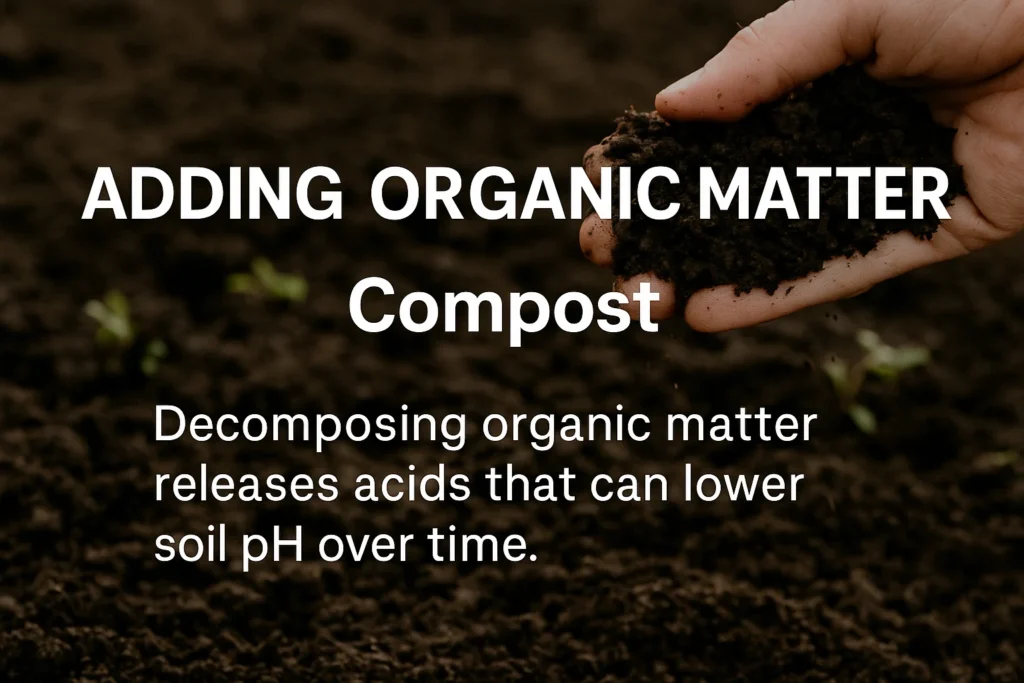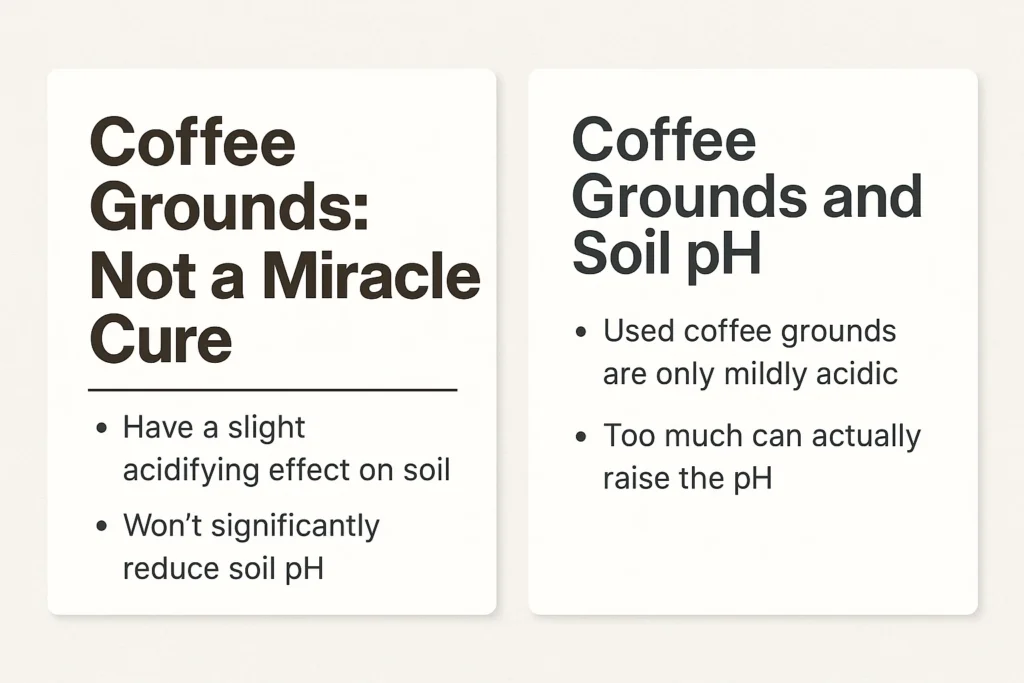How to Lower Soil pH Naturally: Safe, Simple, and Effective Methods

Soil pH plays a bigger role in plant health than most people realize. Whether you’re tending a vegetable garden, managing a lush lawn, or growing finicky blueberries, understanding how to lower soil pH naturally can be the difference between thriving plants and constant frustration.
High soil pH, also known as alkaline soil, often locks away essential nutrients. Iron, manganese, zinc—these are all crucial, yet they become unavailable when pH drifts too high. The result? Yellowing leaves, poor growth, and gardeners wondering what went wrong.
In this guide, we’ll explain how to lower soil pH naturally, why it matters, and the best organic methods to reduce soil alkalinity without harsh chemicals.
🔑 Key Takeaways
- Test soil first; don’t assume high pH is a problem.
- Lowering soil pH naturally involves compost, peat moss, pine needles, sulfur-based amendments.
- For quick results, aluminum sulfate works but requires caution.
- Adjusting soil pH is slow—especially in soils with calcium carbonate (alkaline soils).
- Some fertilizers can maintain low pH but won’t drastically reduce it.
Why Does Soil pH Matter?
Soil pH determines how well plants absorb nutrients. For most garden plants, a slightly acidic soil (pH 6.0–6.8) is ideal. Certain plants, like blueberries, azaleas, and hydrangeas, demand even lower pH levels.
When soil becomes too alkaline, nutrients get “locked up,” unavailable to plant roots. This can happen naturally or be caused by things like hard water, excessive liming, or even location-specific soil types.
Interestingly, some gardeners report decent yields despite slightly alkaline soil, while others struggle with even minor pH imbalances. It’s not an exact science—microclimates, soil texture, and organic matter all play subtle roles.
Still, knowing how to lower soil pH naturally equips you to create better growing conditions.
Step 1: Always Test Your Soil First
Before attempting to adjust anything, conduct a soil pH test. This step is often skipped, leading to ineffective solutions or even making the problem worse.
Use a simple pH testing kit from your garden center or send a sample to your local extension office. Whether you’re learning how to reduce soil alkalinity or just verifying your garden’s condition, testing provides a clear starting point.
Step 2: How to Lower Soil pH Naturally — Effective Organic Methods
Elemental Sulfur
Peat Moss
Compost & Organics
Pine Needles & Mulch
Vinegar (Diluted)
Coffee Grounds
Elemental Sulfur: The Gold Standard
When people ask how to lower soil pH naturally, elemental sulfur is usually the first answer. Soil bacteria convert sulfur into sulfuric acid, gently lowering pH over several months.
- Sandy soils respond faster.
- Clay-heavy soils require more time and sulfur.
- Changes aren’t instant but are long-lasting.
Some may argue that aluminum sulfate works quicker, but it carries toxicity risks. Elemental sulfur, while slower, supports soil health in the long run.
Peat Moss: Acidic & Practical
Sphagnum peat moss is another excellent amendment. Its natural acidity helps lower pH while improving soil structure and water retention.
However, there’s some debate about its sustainability. Alternatives like coconut coir exist, though they don’t acidify soil. If your goal is specifically how to make soil more acidic, peat moss is effective, but moderation is key.
Compost & Organic Matter: Slow & Steady
Adding compost may not dramatically lower pH immediately, but it supports microbial activity, which contributes to gradual acidification. For those learning how do you increase acidity in soil, compost is part of the puzzle, not a standalone solution.
Some gardeners swear by compost mulching to adjust pH, while others see minimal impact. Soil type, compost ingredients, and climate can all affect results.
Acidic Mulches: Pine Needles & Oak Leaves
Pine needles and oak leaves make excellent mulches for acid-loving plants. While they don’t drastically lower soil pH on their own, they help maintain acidic surface layers.
For anyone wondering how to reduce soil alkalinity without chemicals, these mulches are a natural, low-effort addition.
Step 3: Quick Fixes & Common Myths
Vinegar: Temporary and Risky
Vinegar is frequently mentioned as a fast way to lower pH. In controlled, diluted applications, it can slightly acidify soil—but only temporarily.
- Useful for potted plants or small garden patches.
- Not recommended for large-scale use.
- Overuse can harm beneficial microbes and plant roots.
For urgent, small fixes, vinegar is an option, but it’s not the answer for those seeking how to lower soil pH naturally in a sustainable way.
Coffee Grounds: Not a Miracle Cure
Many believe coffee grounds can acidify soil, but in reality, their pH is close to neutral after brewing. While they add organic matter, they won’t significantly lower pH.
If you’re curious how to adjust pH in soil effectively, focus on sulfur and peat moss instead. Coffee grounds are better suited for compost piles.
Contrary to popular belief, used coffee grounds do not significantly lower soil pH. University of Minnesota Extension explains why.
Special Considerations: Lawns, Containers, & Blueberries
- Lawns: Elemental sulfur can help, but lowering lawn soil pH is a gradual process. Chemical treatments might seem tempting but come with risks.
- Potted Plants: Easier to adjust using acidic potting mixes and peat-based amendments.
- Blueberries: Require consistent pH management through sulfur, acidic mulching, and avoiding alkaline tap water.
Learning how to lower soil pH naturally for these special cases involves patience and consistency.
Common Mistakes to Avoid
- Skipping testing: Always know your starting pH.
- Overapplying amendments: Too much sulfur can backfire.
- Ignoring soil type: Sandy soils vs. clay soils respond differently.
- Expecting instant results: Natural methods are gradual by nature.
Even seasoned gardeners sometimes over-correct or misapply solutions. Being mindful prevents costly mistakes.
Long-Term Maintenance: The Key to Success
One-time fixes rarely work. Maintaining optimal pH requires ongoing monitoring, especially after heavy rains, irrigation, or organic amendments.
Many gardeners incorporate sulfur annually and apply acidic mulches seasonally. Understanding how to lower soil pH naturally is about developing this rhythm.
Conclusion: Soil Health First, pH Follows
Adjusting soil pH is less about drastic interventions and more about nurturing the soil ecosystem. Through thoughtful use of sulfur, organic matter, and gentle mulches, you can naturally guide your soil to an optimal pH range.
Patience pays off. Instead of chasing quick fixes, embracing a holistic approach ensures long-term plant health and better yields.
Learning how to lower soil pH naturally isn’t a one-time task—it’s a continuous relationship with your garden.
FAQs
How do you lower soil pH naturally without chemicals?
Use elemental sulfur, peat moss, compost, and acidic mulches like pine needles. These methods gradually reduce soil alkalinity without synthetic chemicals.
Does sulfur lower soil pH effectively?
Yes, elemental sulfur is the most reliable natural amendment for lowering pH. It works slowly but provides lasting results.
Can I lower soil pH with vinegar?
Vinegar can temporarily lower pH in small areas but is not recommended for long-term soil health.
How to reduce soil alkalinity for vegetable gardens?
Start with sulfur applications, enrich with compost, and maintain with acidic mulches. Regular soil testing is essential.
How do you increase acidity in soil organically?
By incorporating elemental sulfur, peat moss, compost, and using rainwater for irrigation, you can naturally increase soil acidity over time.
🧮 Related Calculators for Soil Health & Plant Care
Managing soil pH is just one part of nurturing healthy plants. Whether you’re adjusting nutrients, optimizing irrigation, or planning your garden layout, these calculators can help you make data-driven decisions:
🟢 Soil & Fertilizer Calculators
- Soil pH Calculator
Quickly estimate your soil’s pH and understand its impact on plant growth. - Soil Fertilizer Calculator
Calculate the right amount of fertilizer based on your soil test results. - NPK Fertilizer Calculator
Balance nitrogen, phosphorus, and potassium to maintain ideal nutrient levels. - Compost Calculator
Determine how much compost you need to improve soil structure and acidity.
💧 Irrigation & Watering Calculators
- Drip Irrigation Flow Rate Calculator
Optimize your drip system for efficient watering and avoid over-irrigation in alkaline soils. - Drip Irrigation Run Time Calculator
Calculate how long to run your irrigation to maintain consistent soil moisture. - Indoor Plant Watering Calculator
Get personalized watering schedules for indoor plants sensitive to soil pH.
🌱 Garden & Landscape Calculators
- Garden & Plant Spacing Calculator
Plan your garden layout with correct spacing to prevent competition in acidic soil. - Raised Garden Bed Soil Calculator
Estimate soil volume needed for raised beds, perfect for controlled pH environments. - Mulch Calculator
Calculate how much mulch (pine needles, oak leaves) you need to maintain soil acidity.
🌿 Advanced Grower Tools
- Hydroponics Calculator
Fine-tune pH and nutrient solutions for soilless growing systems. - VPD Calculator & Chart (Vapor Pressure Deficit)
Manage humidity and transpiration rates for plants sensitive to pH fluctuations. - Daily Light Integral (DLI) Calculator
Ensure your acid-loving plants receive optimal light for photosynthesis.
➡️ Explore All Calculators
Looking for more tools? Visit our full collection of Plant Calculators to optimize every aspect of your garden and farm.


